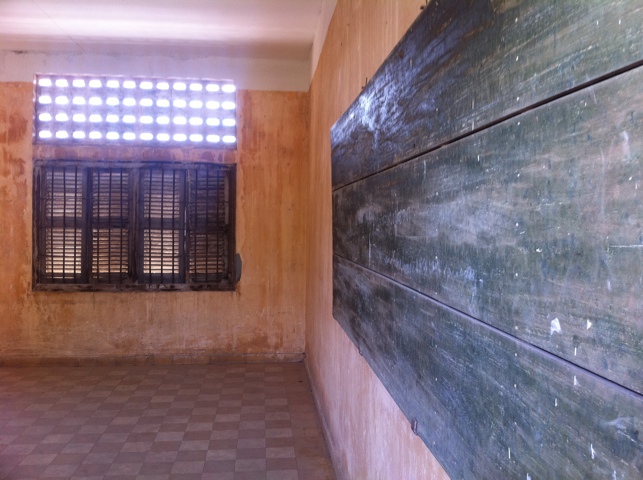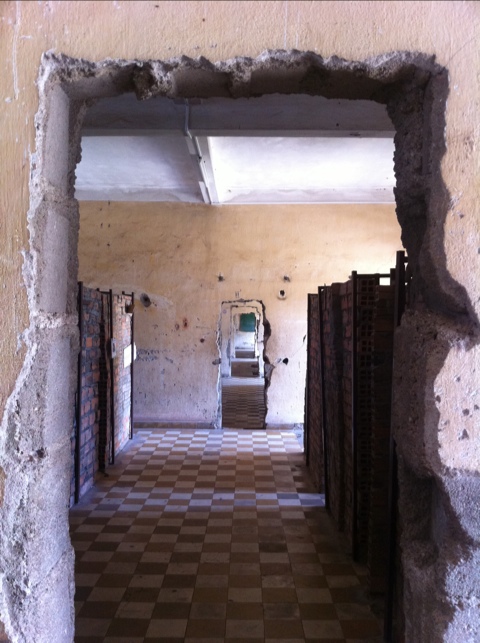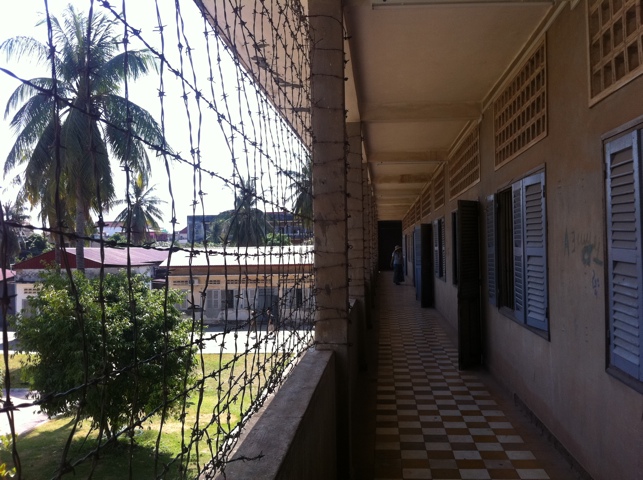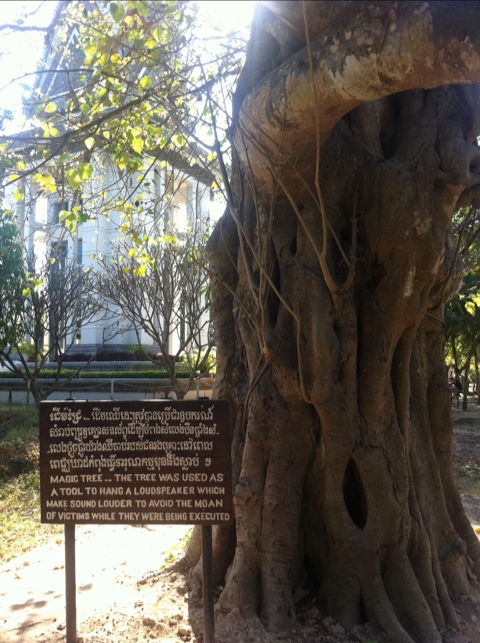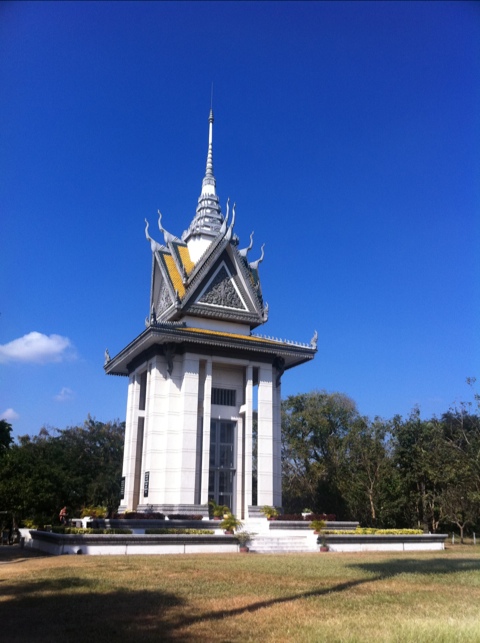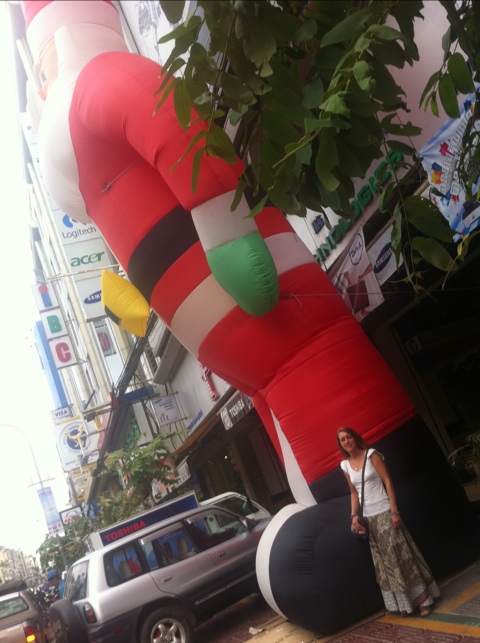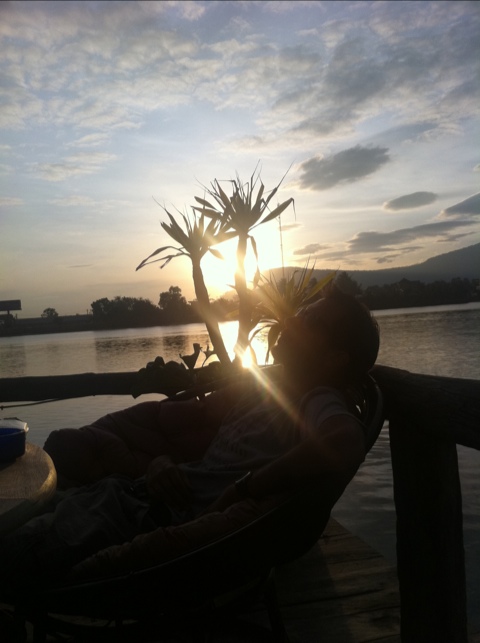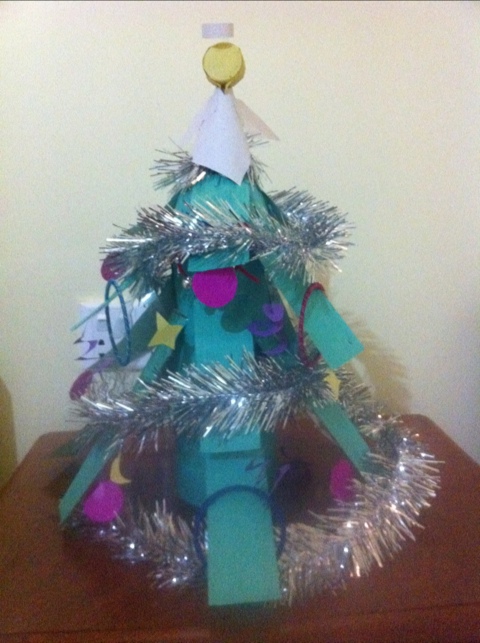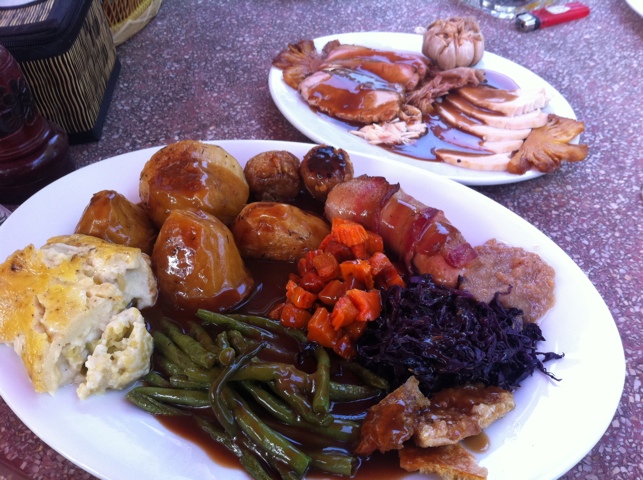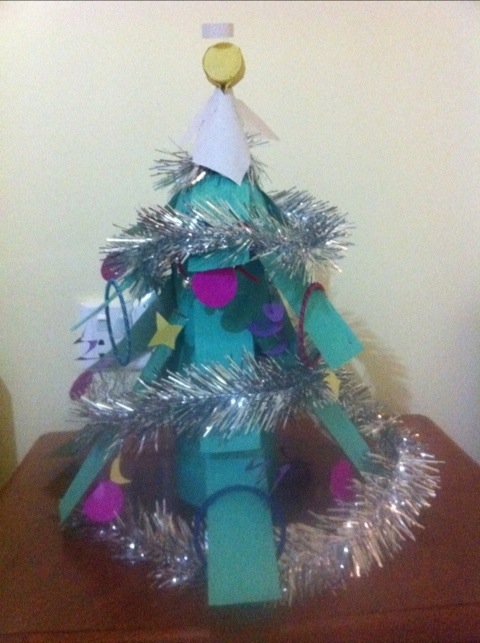We visited a school yesterday. Its design reminded me of a Lycée I spent a day at many years ago in Paris, with multi-story blocks surrounding an open courtyard, and a chequered tile floor. This one sounded different though.
Schoolyards are meant to echo with the sounds of children playing, the shrieks of delight and footballs skidding around – but there was silence. The tattered blackboards were chalked with rules that preached total submission to those in charge. From the gym equipment in the yard hung a series of metal loops used for torture. And there were 14 anonymous graves in the ground outside one of the former classrooms. We were here to witness the remnants of the horrors of the three year, eight month and 20 day rule of the Khmer Rouge. It was probably the most heartbreakingly shocking thing I have ever seen.
Reading Jung Chang’s amazing book Wild Swans had given me a sense of the utter brutalistic lunacy of China under Mao, with his attempt to violently force everyone into the working class, turning man against man through successive purges and by fomenting chaos in the belief that only through repeated revolution could there be radical change. Pol Pot followed these beliefs fervently, but apparently sought even more rapid and forceful upheaval. The school we visited was S21, one of many prisons set up to interrogate and torture those who disagreed, or who in many cases were just caught up in the maelstrom of revolution and suspicion.
Over the course of just under four years of rule, between one and three million people were killed, either executed en mass using farm tools (bullets were too expensive) like the 17,000 who passed through S21, or starved to death in the fields working from four in the morning until ten at night with only a few grains of rice to eat each day. Even by the most conservative estimate, that’s one death for every two minutes they were in power. In all, it’s believed that around 1/4 of the Cambodian population died under the Khmer Rouge.
The sheer psychotic madness of their beliefs is preserved in the slogans of the revolution. Most aptly for our venue, one was “Study is not important. What’s important is Work and Revolution”. In line with this, all schools and universities were closed, many to become prison camps. The same happened to many prisons, and the entire urban population was moved to the countryside to do hard labour and learn from the peasants, Mao’s equivalent of intellectual role models. As an indication of how rapidly this happened, it took just 3 days for the entire population of Phnom Penh to be evicted – some 2.5 million people.
Walking round, two things really brought the reality home for me. The first was how much the building was so evidently a colonial era school that had been crudely and swiftly brutalised into a prison. The masonry walls between classrooms had been punctured by primitive sledgehammer doorways, and the classrooms divided by rough brickwork into lines of tiny cells, each just big enough for an individual to lie down. The window openings in the open air corridors had been wrapped in barbed wire to prevent desperate prisoners from escaping by committing suicide. Many of the rooms still had their contents, rusting iron beds and shackles; an interrogator’s wooden chair; an ammunition box which was used for excrement. There were photos and paintings showing what it had been like. And running through all of this was the distinct, chilling reminder that this had all happened right where we stood – on the dusty, dirty yellow and white chequered schoolroom tiles beneath our feet.
The other thing that will stay with me were the faces staring out from the thousands of mugshot photographs. Each detainee was photographed on arrival, and of the 17,000 recorded in the files, only around 140 ever made it out alive.
In the afternoon, we went to Choeung Ek, the ‘killing fields’ where those from S21 were executed and buried in mass graves. A thought provoking audio tour gave plenty of opportunity for quiet reflection as we walked around the grave mounds and memorial stupa, where the victims’ bones are now kept. The barbarism of the regime meant that in many cases entire families were exterminated, including babies, following Pol Pot’s mantra that “to dig up the grass, one must remove even the roots.”
Poignantly, where indescribable horrors once occurred there is now an abundance of butterflies hovering between the greenery, their fluttering wings bringing colour – and life – to the grey piles of skulls of the past.
As you sit there in the shade by the brown shimmering lake, next to the gleaming green rice paddies and alongside the gold-topped memorial, you have to ask yourself how such atrocities can happen – and indeed can continue to happen. The Khmer Rouge’s massacres happened only just before I was born, continuing a chain that includes Nazi Germany and more recently Iraq, Serbia, Rwanda – and Palestine, Lebanon, Sri Lanka and perhaps even right now, in Syria.
I think my normal answer would be to say this is why we need to strengthen and have faith in international structures like the UN, which can use democracy and international law to bear on those who commit such acts. However, I must say that my faith was left severely lacking by how justice has played out after the Khmer Rouge were routed, illustrating how the very strength of geopolitics is also its undoing. As I understand it, the problem was that it was the Vietnamese that defeated the Khmer Rouge, forcing Pol Pot & co to flee to the border with Thailand and a new government to take over and pick up the pieces. With the geopolitics of the cold war in full swing, few were happy to side with communist Vietnam, and so instead China, Thailand, the US and even the UK supported Pol Pot and the Khmer Rouge government in exile, channelling them aid money and even continuing to recognise the Khmer Rouge as Cambodia’s official government internationally in the UN. It was only in the mid 1990s that things started to change for the better with recognition that the Khmer Rouge was still seeking violence, and only in 2003 that four of its former leaders were put on trial, the hearing eventually starting in July 2006. The sad reality is that many of the perpetrators will never face justice due to old age – Pol Pot himself died in 1998, and many more have ingratiated themselves with the new regime. The one trial to have concluded so far – that of ‘Comrade Duch’ who ran S21 – resulted in him receiving a sentence of 35 years, which when time is taken off for his incarceration while awaiting trial is equivalent to 11 hours and 30 minutes for each execution under his command.
As we sit here on our sweaty bus out of Phnom Penh to adventures new, I can’t help but hear the voice of one of the survivors echoing in my mind. He was pleading for those who visited to take away from the horrors a greater understanding of how such genocide can happen to anyone, and how we must all work to prevent such atrocities in the future. I just wish the answers to these questions were a little more clear.
Simon


